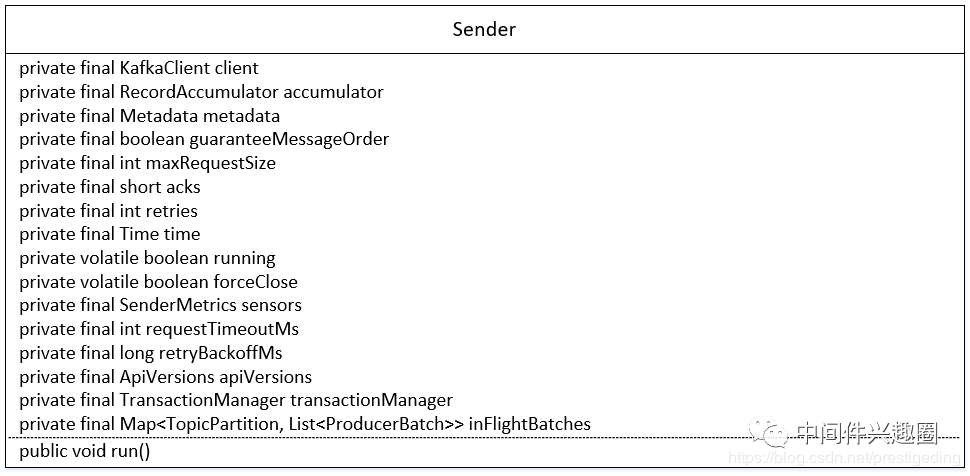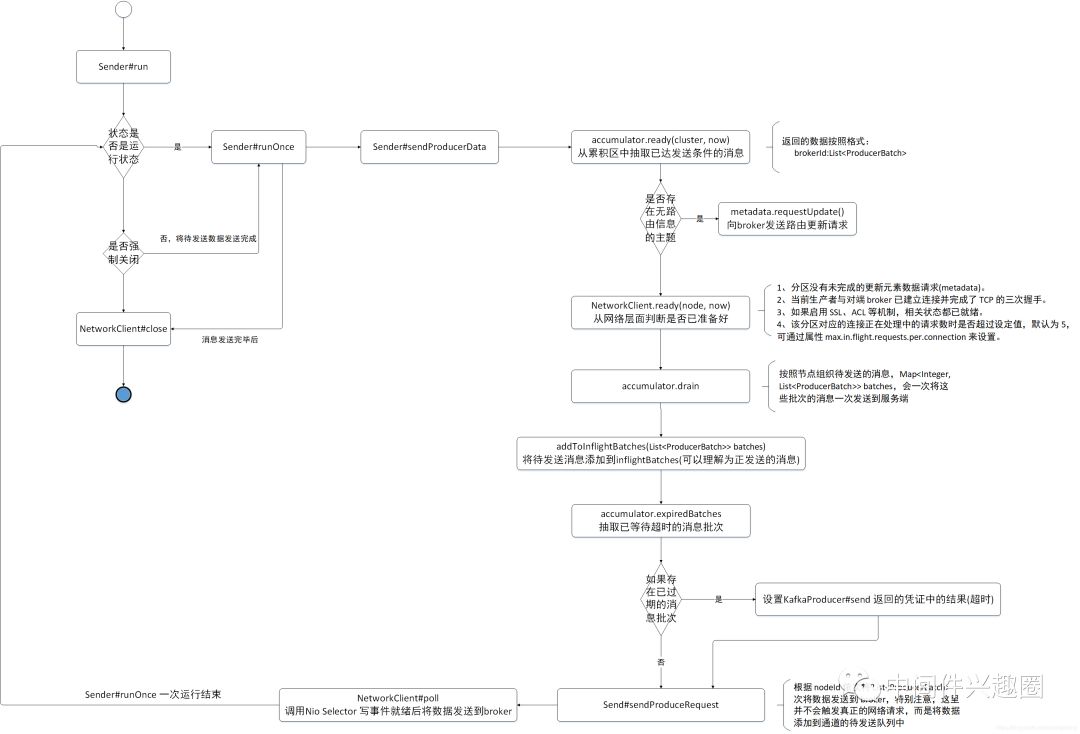温馨提示:本文基于 Kafka 2.2.1 版本。如果觉得源码阅读比较枯燥,本文的中间有 Sender 线程的工作流程图。
上文 《源码分析 Kafka 消息发送流程》 已经详细介绍了 KafkaProducer send 方法的流程,该方法只是将消息追加到 KafKaProducer 的缓存中,并未真正的向 broker 发送消息,本文将来探讨 Kafka 的 Sender 线程。
在 KafkaProducer 中会启动一个单独的线程,其名称为 “kafka-producer-network-thread | clientID”,其中 clientID 为生产者的 id 。
1、Sender 线程详解
1.1 类图

我们先来看一下其各个属性的含义:
KafkaClient client
kafka 网络通信客户端,主要封装与 broker 的网络通信。RecordAccumulator accumulator
消息记录累积器,消息追加的入口(RecordAccumulator 的 append 方法)。Metadata metadata
元数据管理器,即 topic 的路由分区信息。boolean guaranteeMessageOrder
是否需要保证消息的顺序性。int maxRequestSize
调用 send 方法发送的最大请求大小,包括 key、消息体序列化后的消息总大小不能超过该值。通过参数 max.request.size 来设置。short acks
用来定义消息“已提交”的条件(标准),就是 Broker 端向客户端承偌已提交的条件,可选值如下0、-1、1.int retries
重试次数。Time time
时间工具类。boolean running
该线程状态,为 true 表示运行中。boolean forceClose
是否强制关闭,此时会忽略正在发送中的消息。SenderMetrics sensors
消息发送相关的统计指标收集器。int requestTimeoutMs
请求的超时时间。long retryBackoffMs
请求失败时在重试之前等待的时间。ApiVersions apiVersions
API版本信息。TransactionManager transactionManager
事务处理器。Map< TopicPartition, List< ProducerBatch>> inFlightBatches
正在执行发送相关的消息批次。
1.2 run 方法详解
Sender#run
public void run() { log.debug("Starting Kafka producer I/O thread."); while (running) { try { runOnce(); // @1 } catch (Exception e) { log.error("Uncaught error in kafka producer I/O thread: ", e); } } log.debug("Beginning shutdown of Kafka producer I/O thread, sending remaining records."); while (!forceClose && (this.accumulator.hasUndrained() || this.client.inFlightRequestCount() > 0)) { // @2 try { runOnce(); } catch (Exception e) { log.error("Uncaught error in kafka producer I/O thread: ", e); } } if (forceClose) { // @3 log.debug("Aborting incomplete batches due to forced shutdown"); this.accumulator.abortIncompleteBatches(); } try { this.client.close(); // @4 } catch (Exception e) { log.error("Failed to close network client", e); } log.debug("Shutdown of Kafka producer I/O thread has completed.");}
代码@1:Sender 线程在运行状态下主要的业务处理方法,将消息缓存区中的消息向 broker 发送。
代码@2:如果主动关闭 Sender 线程,如果不是强制关闭,则如果缓存区还有消息待发送,再次调用 runOnce 方法将剩余的消息发送完毕后再退出。
代码@3:如果强制关闭 Sender 线程,则拒绝未完成提交的消息。
代码@4:关闭 Kafka Client 即网络通信对象。
接下来将分别探讨其上述方法的实现细节。
1.2.1 runOnce 详解
Sender#runOnce
void runOnce() { // 此处省略与事务消息相关的逻辑 long currentTimeMs = time.milliseconds(); long pollTimeout = sendProducerData(currentTimeMs); // @1 client.poll(pollTimeout, currentTimeMs); // @2}
本文不关注事务消息的实现原理,故省略了该部分的代码。
代码@1:调用 sendProducerData 方法发送消息。
代码@2:调用这个方法的作用?
接下来分别对上述两个方法进行深入探究。
1.1.2.1 sendProducerData
接下来将详细分析其实现步骤。
Sender#sendProducerData
Cluster cluster = metadata.fetch();// get the list of partitions with data ready to sendRecordAccumulator.ReadyCheckResult result = this.accumulator.ready(cluster, now);
Step1:首先根据当前时间,根据缓存队列中的数据判断哪些 topic 的 哪些分区已经达到发送条件。达到可发送的条件将在 2.1.1.1 节详细分析。
Sender#sendProducerData
if (!result.unknownLeaderTopics.isEmpty()) { for (String topic : result.unknownLeaderTopics) this.metadata.add(topic); log.debug("Requesting metadata update due to unknown leader topics from the batched records: {}", result.unknownLeaderTopics); this.metadata.requestUpdate();}
Step2:如果在待发送的消息未找到其路由信息,则需要首先去 broker 服务器拉取对应的路由信息(分区的 leader 节点信息)。
Sender#sendProducerData
long notReadyTimeout = Long.MAX_VALUE;while (iter.hasNext()) { Node node = iter.next(); if (!this.client.ready(node, now)) { iter.remove(); notReadyTimeout = Math.min(notReadyTimeout, this.client.pollDelayMs(node, now)); }}
Step3:移除在网络层面没有准备好的分区,并且计算在接下来多久的时间间隔内,该分区都将处于未准备状态。
1、在网络环节没有准备好的标准如下:
分区没有未完成的更新元素数据请求(metadata)。
当前生产者与对端 broker 已建立连接并完成了 TCP 的三次握手。
如果启用 SSL、ACL 等机制,相关状态都已就绪。
该分区对应的连接正在处理中的请求数时是否超过设定值,默认为 5,可通过属性 max.in.flight.requests.per.connection 来设置。
2、client pollDelayMs 预估分区在接下来多久的时间间隔内都将处于未转变好状态(not ready),其标准如下:
如果已与对端的 TCP 连接已创建好,并处于已连接状态,此时如果没有触发限流,则返回0,如果有触发限流,则返回限流等待时间。
如果还位于对端建立 TCP 连接,则返回 Long.MAX_VALUE,因为连接建立好后,会唤醒发送线程的。
Sender#sendProducerData
// create produce requestsMap<Integer, List<ProducerBatch>> batches = this.accumulator.drain(cluster, result.readyNodes, this.maxRequestSize, now);
Step4:根据已准备的分区,从缓存区中抽取待发送的消息批次( ProducerBatch ),并且按照 nodeId:List 组织,注意,抽取后的 ProducerBatch 将不能再追加消息了,就算还有剩余空间可用,具体抽取将在下文在详细介绍。
Sender#sendProducerData
addToInflightBatches(batches);public void addToInflightBatches(Map<Integer, List<ProducerBatch>> batches) { for (List<ProducerBatch> batchList : batches.values()) { addToInflightBatches(batchList); }}private void addToInflightBatches(List<ProducerBatch> batches) { for (ProducerBatch batch : batches) { List<ProducerBatch> inflightBatchList = inFlightBatches.get(batch.topicPartition); if (inflightBatchList == null) { inflightBatchList = new ArrayList<>(); inFlightBatches.put(batch.topicPartition, inflightBatchList); } inflightBatchList.add(batch); }}
Step5:将抽取的 ProducerBatch 加入到 inFlightBatches 数据结构,该属性的声明如下:Map<TopicPartition, List< ProducerBatch >> inFlightBatches,即按照 topic-分区 为键,存放已抽取的 ProducerBatch,这个属性的含义就是存储待发送的消息批次。可以根据该数据结构得知在消息发送时以分区为维度反馈 Sender 线程的“积压情况”,max.in.flight.requests.per.connection 就是来控制积压的最大数量,如果积压达到这个数值,针对该队列的消息发送会限流。
Sender#sendProducerData
accumulator.resetNextBatchExpiryTime();List<ProducerBatch> expiredInflightBatches = getExpiredInflightBatches(now);List<ProducerBatch> expiredBatches = this.accumulator.expiredBatches(now);expiredBatches.addAll(expiredInflightBatches);
Step6:从 inflightBatches 与 batches 中查找已过期的消息批次( ProducerBatch ),判断是否过期的标准是系统当前时间与 ProducerBatch 创建时间之差是否超过120s,过期时间可以通过参数 delivery.timeout.ms 设置。
Sender#sendProducerData
if (!expiredBatches.isEmpty()) log.trace("Expired {} batches in accumulator", expiredBatches.size());for (ProducerBatch expiredBatch : expiredBatches) { String errorMessage = "Expiring " + expiredBatch.recordCount + " record(s) for " + expiredBatch.topicPartition + ":" + (now - expiredBatch.createdMs) + " ms has passed since batch creation"; failBatch(expiredBatch, -1, NO_TIMESTAMP, new TimeoutException(errorMessage), false); if (transactionManager != null && expiredBatch.inRetry()) { // This ensures that no new batches are drained until the current in flight batches are fully resolved. transactionManager.markSequenceUnresolved(expiredBatch.topicPartition); }}
Step7:处理已超时的消息批次,通知该批消息发送失败,即通过设置 KafkaProducer#send 方法返回的凭证中的 FutureRecordMetadata 中的 ProduceRequestResult result,使之调用其 get 方法不会阻塞。
Sender#sendProducerData
sensors.updateProduceRequestMetrics(batches);
Step8:收集统计指标,本文不打算详细分析,但后续会专门对 Kafka 的 Metrics 设计进行一个深入的探讨与学习。
Sender#sendProducerData
long pollTimeout = Math.min(result.nextReadyCheckDelayMs, notReadyTimeout);pollTimeout = Math.min(pollTimeout, this.accumulator.nextExpiryTimeMs() - now);pollTimeout = Math.max(pollTimeout, 0);if (!result.readyNodes.isEmpty()) { log.trace("Nodes with data ready to send: {}", result.readyNodes); pollTimeout = 0;}
Step9:设置下一次的发送延时,待补充详细分析。
Sender#sendProducerData
sendProduceRequests(batches, now);private void sendProduceRequests(Map<Integer, List<ProducerBatch>> collated, long now) { for (Map.Entry<Integer, List<ProducerBatch>> entry : collated.entrySet()) sendProduceRequest(now, entry.getKey(), acks, requestTimeoutMs, entry.getValue());}
Step10:该步骤按照 brokerId 分别构建发送请求,即每一个 broker 会将多个 ProducerBatch 一起封装成一个请求进行发送,同一时间,每一个 与 broker 连接只会只能发送一个请求,注意,这里只是构建请求,并最终会通过 NetworkClient#send 方法,将该批数据设置到 NetworkClient 的待发送数据中,此时并没有触发真正的网络调用。
sendProducerData 方法就介绍到这里了,既然这里还没有进行真正的网络请求,那在什么时候触发呢?
我们继续回到 runOnce 方法。
1.2.1.2 NetworkClient 的 poll 方法
public List<ClientResponse> poll(long timeout, long now) { ensureActive(); if (!abortedSends.isEmpty()) { // If there are aborted sends because of unsupported version exceptions or disconnects, // handle them immediately without waiting for Selector#poll. List<ClientResponse> responses = new ArrayList<>(); handleAbortedSends(responses); completeResponses(responses); return responses; } long metadataTimeout = metadataUpdater.maybeUpdate(now); // @1 try { this.selector.poll(Utils.min(timeout, metadataTimeout, defaultRequestTimeoutMs)); // @2 } catch (IOException e) { log.error("Unexpected error during I/O", e); } // process completed actions long updatedNow = this.time.milliseconds(); List<ClientResponse> responses = new ArrayList<>(); // @3 handleCompletedSends(responses, updatedNow); handleCompletedReceives(responses, updatedNow); handleDisconnections(responses, updatedNow); handleConnections(); handleInitiateApiVersionRequests(updatedNow); handleTimedOutRequests(responses, updatedNow); completeResponses(responses); // @4 return responses;}
本文并不会详细深入探讨其网络实现部分,Kafka 的 网络通讯后续我会专门详细的介绍,在这里先点出其关键点。
代码@1:尝试更新云数据。
代码@2:触发真正的网络通讯,该方法中会通过收到调用 NIO 中的 Selector#select() 方法,对通道的读写就绪事件进行处理,当写事件就绪后,就会将通道中的消息发送到远端的 broker。
代码@3:然后会消息发送,消息接收、断开连接、API版本,超时等结果进行收集。
代码@4:并依次对结果进行唤醒,此时会将响应结果设置到 KafkaProducer#send 方法返回的凭证中,从而唤醒发送客户端,完成一次完整的消息发送流程。
Sender 发送线程的流程就介绍到这里了,接下来首先给出一张流程图,然后对上述流程中一些关键的方法再补充深入探讨一下。
1.2.2 run 方法流程图

根据上面的源码分析得出上述流程图,图中对重点步骤也详细标注了其关键点。下面我们对上述流程图中 Sender 线程依赖的相关类的核心方法进行解读,以便加深 Sender 线程的理解。
由于在讲解 Sender 发送流程中,大部分都是调用 RecordAccumulator 方法来实现其特定逻辑,故接下来重点对上述涉及到 RecordAccumulator 的方法进行一个详细剖析,加强对 Sender 流程的理解。
2、RecordAccumulator 核心方法详解
2.1 RecordAccumulator 的 ready 方法详解
该方法主要就是根据缓存区中的消息,判断哪些分区已经达到发送条件。
RecordAccumulator#ready
public ReadyCheckResult ready(Cluster cluster, long nowMs) { Set<Node> readyNodes = new HashSet<>(); long nextReadyCheckDelayMs = Long.MAX_VALUE; Set<String> unknownLeaderTopics = new HashSet<>(); boolean exhausted = this.free.queued() > 0; for (Map.Entry<TopicPartition, Deque<ProducerBatch>> entry : this.batches.entrySet()) { // @1 TopicPartition part = entry.getKey(); Deque<ProducerBatch> deque = entry.getValue(); Node leader = cluster.leaderFor(part); // @2 synchronized (deque) { if (leader == null && !deque.isEmpty()) { // @3 // This is a partition for which leader is not known, but messages are available to send. // Note that entries are currently not removed from batches when deque is empty. unknownLeaderTopics.add(part.topic()); } else if (!readyNodes.contains(leader) && !isMuted(part, nowMs)) { // @4 ProducerBatch batch = deque.peekFirst(); if (batch != null) { long waitedTimeMs = batch.waitedTimeMs(nowMs); boolean backingOff = batch.attempts() > 0 && waitedTimeMs < retryBackoffMs; long timeToWaitMs = backingOff ? retryBackoffMs : lingerMs; boolean full = deque.size() > 1 || batch.isFull(); boolean expired = waitedTimeMs >= timeToWaitMs; boolean sendable = full || expired || exhausted || closed || flushInProgress(); if (sendable && !backingOff) { // @5 readyNodes.add(leader); } else { long timeLeftMs = Math.max(timeToWaitMs - waitedTimeMs, 0); // Note that this results in a conservative estimate since an un-sendable partition may have // a leader that will later be found to have sendable data. However, this is good enough // since we'll just wake up and then sleep again for the remaining time. nextReadyCheckDelayMs = Math.min(timeLeftMs, nextReadyCheckDelayMs); } } } } } return new ReadyCheckResult(readyNodes, nextReadyCheckDelayMs, unknownLeaderTopics);}
代码@1:对生产者缓存区 ConcurrentHashMap<TopicPartition, Deque< ProducerBatch>> batches 遍历,从中挑选已准备好的消息批次。
代码@2:从生产者元数据缓存中尝试查找分区(TopicPartition) 的 leader 信息,如果不存在,当将该 topic 添加到 unknownLeaderTopics (代码@3),稍后会发送元数据更新请求去 broker 端查找分区的路由信息。
代码@4:如果不在 readyNodes 中就需要判断是否满足条件,isMuted 与顺序消息有关,本文暂时不关注,在后面的顺序消息部分会重点探讨。
代码@5:这里就是判断是否准备好的条件,先一个一个来解读局部变量的含义。
long waitedTimeMs
该 ProducerBatch 已等待的时长,等于当前时间戳 与 ProducerBatch 的 lastAttemptMs 之差,在 ProducerBatch 创建时或需要重试时会将当前的时间赋值给lastAttemptMs。retryBackoffMs
当发生异常时发起重试之前的等待时间,默认为 100ms,可通过属性 retry.backoff.ms 配置。batch.attempts()
该批次当前已重试的次数。backingOff
后台发送是否关闭,即如果需要重试并且等待时间小于 retryBackoffMs ,则 backingOff = true,也意味着该批次未准备好。timeToWaitMs
send 线程发送消息需要的等待时间,如果 backingOff 为 true,表示该批次是在重试,并且等待时间小于系统设置的需要等待时间,这种情况下 timeToWaitMs = retryBackoffMs 。否则需要等待的时间为 lingerMs。boolean full 该批次是否已满,如果两个条件中的任意一个满足即为 true。
Deque< ProducerBatch> 该队列的个数大于1,表示肯定有一个 ProducerBatch 已写满。
ProducerBatch 已写满。
boolean expired
是否过期,等于已经等待的时间是否大于需要等待的时间,如果把发送看成定时发送的话,expired 为 true 表示定时器已到达触发点,即需要执行。boolean exhausted
当前生产者缓存已不够,创建新的 ProducerBatch 时阻塞在申请缓存空间的线程大于0,此时应立即将缓存区中的消息立即发送到服务器。boolean sendable 是否可发送。其满足下面的任意一个条件即可:
该批次已写满。(full = true)。
已等待系统规定的时长。(expired = true)
发送者内部缓存区已耗尽并且有新的线程需要申请(exhausted = true)。
该发送者的 close 方法被调用(close = true)。
该发送者的 flush 方法被调用。
2.2 RecordAccumulator 的 drain方法详解
RecordAccumulator#drain
public Map<Integer, List<ProducerBatch>> drain(Cluster cluster, Set<Node> nodes, int maxSize, long now) { // @1 if (nodes.isEmpty()) return Collections.emptyMap(); Map<Integer, List<ProducerBatch>> batches = new HashMap<>(); for (Node node : nodes) { List<ProducerBatch> ready = drainBatchesForOneNode(cluster, node, maxSize, now); // @2 batches.put(node.id(), ready); } return batches;}
代码@1:我们首先来介绍该方法的参数:
Cluster cluster
集群信息。Set< Node> nodes
已准备好的节点集合。int maxSize
一次请求最大的字节数。long now
当前时间。
代码@2:遍历所有节点,调用 drainBatchesForOneNode 方法抽取数据,组装成 Map<Integer /** brokerId */, List< ProducerBatch>> batches。
接下来重点来看一下 drainBatchesForOneNode。
RecordAccumulator#drainBatchesForOneNode
private List<ProducerBatch> drainBatchesForOneNode(Cluster cluster, Node node, int maxSize, long now) { int size = 0; List<PartitionInfo> parts = cluster.partitionsForNode(node.id()); // @1 List<ProducerBatch> ready = new ArrayList<>(); int start = drainIndex = drainIndex % parts.size(); // @2 do { // @3 PartitionInfo part = parts.get(drainIndex); TopicPartition tp = new TopicPartition(part.topic(), part.partition()); this.drainIndex = (this.drainIndex + 1) % parts.size(); if (isMuted(tp, now)) continue; Deque<ProducerBatch> deque = getDeque(tp); // @4 if (deque == null) continue; synchronized (deque) { // invariant: !isMuted(tp,now) && deque != null ProducerBatch first = deque.peekFirst(); // @5 if (first == null) continue; // first != null boolean backoff = first.attempts() > 0 && first.waitedTimeMs(now) < retryBackoffMs; // @6 // Only drain the batch if it is not during backoff period. if (backoff) continue; if (size + first.estimatedSizeInBytes() > maxSize && !ready.isEmpty()) { // @7 break; } else { if (shouldStopDrainBatchesForPartition(first, tp)) break; // 这里省略与事务消息相关的代码,后续会重点学习。 batch.close(); // @8 size += batch.records().sizeInBytes(); ready.add(batch); batch.drained(now); } } } while (start != drainIndex); return ready;}
代码@1:根据 brokerId 获取该 broker 上的所有主分区。
代码@2:初始化 start。这里首先来阐述一下 start 与 drainIndex 。
start 当前开始遍历的分区序号。
drainIndex 上次抽取的队列索引后,这里主要是为了每个队列都是从零号分区开始抽取。
代码@3:循环从缓存区抽取对应分区中累积的数据。
代码@4:根据 topic + 分区号从生产者发送缓存区中获取已累积的双端Queue。
代码@5:从双端队列的头部获取一个元素。(消息追加时是追加到队列尾部)。
代码@6:如果当前批次是重试,并且还未到阻塞时间,则跳过该分区。
代码@7:如果当前已抽取的消息总大小 加上新的消息已超过 maxRequestSize,则结束抽取。
代码@8:将当前批次加入到已准备集合中,并关闭该批次,即不在允许向该批次中追加消息。
关于消息发送就介绍到这里,NetworkClient 的 poll 方法内部会调用 Selector 执行就绪事件的选择,并将抽取的消息通过网络发送到 Broker 服务器,关于网络后面的具体实现,将在后续文章中单独介绍。
如果文章对您有所帮助的话,麻烦帮忙点【在看】,谢谢您的认可与支持。
中间件兴趣圈已经陆续发表了源码分析Dubbo、ElasticJob、Mybatis、RocketMQ系列,RocketMQ实战与案例分析、ElasticSearch使用指南等。

本文分享自微信公众号 - 中间件兴趣圈(dingwpmz_zjj)。
如有侵权,请联系 support@oschina.cn 删除。
本文参与“OSC源创计划”,欢迎正在阅读的你也加入,一起分享。













